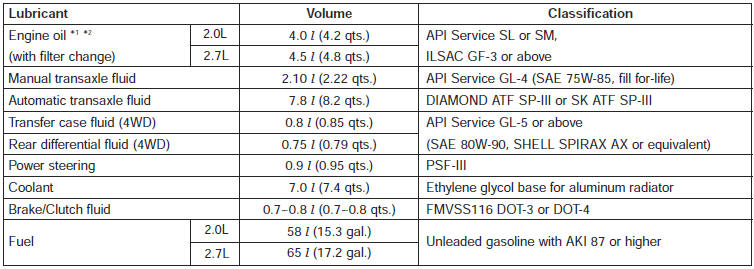Recommended lubricants and capacities
To help achieve proper engine and powertrain performance and durability, use only lubricants of the proper quality. The correct lubricants also help promote engine efficiency that results in improved fuel economy.
These lubricants and fluids are recommended for use in your vehicle.

*1 Refer to the recommended SAE viscosity numbers on the next page.
*2 Engine oils labeled Energy Conserving Oil are now available. Along with other additional benefits, they contribute to fuel economy by reducing the amount of fuel necessary to overcome engine friction. Often, these improvements are difficult to measure in everyday driving, but in a year’s time, they can offer significant cost and energy savings.
Recommended SAE viscosity number
CAUTION
Always be sure to clean the area
around any filler plug, drain
plug, or dipstick before checking
or draining any lubricant.
This is especially important in dusty or sandy areas and when the vehicle is used on unpaved roads. Cleaning the plug and dipstick areas will prevent dirt and grit from entering the engine and other mechanisms that could be damaged.
Engine oil viscosity (thickness) has an effect on fuel economy and cold weather operating (starting and oil flow). Lower viscosity engine oils can provide better fuel economy and cold weather performance, however, higher viscosity engine oils are required for satisfactory lubrication in hot weather. Using oils of any viscosity other than those recommended could result in engine damage.
When choosing an oil, consider the
range of temperature your vehicle
will be operated in before the next oil
change. Proceed to select the recommended
oil viscosity from the
chart.

1. For better fuel economy, it is recommended to use the engine oil of a
viscosity grade SAE 5W-
20, 5W-30 (API SL, SM / ILSAC GF-3). However, if the engine oil is not available
in your country,
select the proper engine oil using the engine oil viscosity chart.
See also:
Interior features
Cigarette lighter (if equipped)
For the cigarette lighter to work, the ignition
switch must be in the ACC or ON
position.
To use the cigarette lighter, push it all the
way into its socket. When ...
Introduction
Let's be clear right up front: The 2010 Kia Sportage is a good little
crossover SUV. The only problem is that the hyper-competitive compact crossover
segment is one of those places where being goo ...
Rearview camera
The rearview camera will activate when
the back-up light is ON with the ignition
switch ON and the shift lever in the R
(Reverse) position.
This system is a supplemental system
that shows beh ...


